Q1. In drawing triangle ABC, it is given that AB = 3 cm, BC = 2 cm and AC = 6 cm. It is not possible to draw the triangle as:
Solution
We know that in a triangle, sum of two sides is greater than the third side.
Here, AB + BC = 5 cm and AC = 6 cm
So, we have: AC > AB + BC
Thus, it is not possible to construct triangle ABC with given measurements.
Q2. Construct a triangle whose perimeter is 13.5 cm and the ratio of the three sides is 2: 3: 4.
Solution
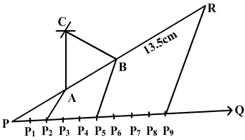 Steps of construction.
1.Draw a line segment PR of length 13.5 cm.
2. At the point P draw ray PQ making any acute angle RPQ with Pr.
3. On PQ mark 9 (2+3+ 4) points P1, P2, P3, P4, P5, P6, P7, P8, P9 such that PP1 = P1P2 = P2P3 = P3P4 = P4P5 = P5P6 = P6P7 = P7P8 = P8P9.
4. Join P9R.
5. Through P2 and P5 draw ray P2A and P5B respectively parallel to P9R intersecting PR at A and B respectively.
6. With A as centre and radius AP draw an arc.
7. With B as centre draw another arc to intersect the arc of step 6 at C.
8. Join CA and CB.
Then ABC is the required triangle.
Steps of construction.
1.Draw a line segment PR of length 13.5 cm.
2. At the point P draw ray PQ making any acute angle RPQ with Pr.
3. On PQ mark 9 (2+3+ 4) points P1, P2, P3, P4, P5, P6, P7, P8, P9 such that PP1 = P1P2 = P2P3 = P3P4 = P4P5 = P5P6 = P6P7 = P7P8 = P8P9.
4. Join P9R.
5. Through P2 and P5 draw ray P2A and P5B respectively parallel to P9R intersecting PR at A and B respectively.
6. With A as centre and radius AP draw an arc.
7. With B as centre draw another arc to intersect the arc of step 6 at C.
8. Join CA and CB.
Then ABC is the required triangle.
Q3. Draw
a pair of tangent to a circle of radius 5 cm which are inclined to each other
at an angle of 60o.
Solution
Rough
figure:
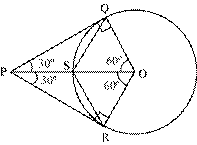 Consider
the given figure PQ and PR are the tangents to the given circle.
If
they are inclined at 60o, then
Consider
the given figure PQ and PR are the tangents to the given circle.
If
they are inclined at 60o, then  QPO =
QPO =  OPR = 30o
Hence
OPR = 30o
Hence
 POQ =
POQ =  POR = 60o
Consider
POR = 60o
Consider  QSO
QSO
 QOS = 60o
OQ =
OS (radius)
So,
QOS = 60o
OQ =
OS (radius)
So,  OQS =
OQS =
 OSQ = 60o
OSQ = 60o
 QSO
is an equilateral triangle
So QS
= SO = QO = radius
QSO
is an equilateral triangle
So QS
= SO = QO = radius
 PQS =
90° -
PQS =
90° -  OQS = 90o - 60o = 30o
OQS = 90o - 60o = 30o
 QPS =
30o
PS =
SQ (isosceles
triangle)
Hence
PS = SQ = OS (radius)
Now
we may draw tangents on the circle as following:
1.
Draw a circle of 5 cm radius and with centre O.
2.
Take a point P on circumference of this circle. Extend OP to Q such that OP =
PQ.
3.
Midpoint of OQ is P. Draw a circle with radius OP with centre as P.
Let
it intersect our circle at R and S. Join QR and QS. QR and QS are required
tangents.
QPS =
30o
PS =
SQ (isosceles
triangle)
Hence
PS = SQ = OS (radius)
Now
we may draw tangents on the circle as following:
1.
Draw a circle of 5 cm radius and with centre O.
2.
Take a point P on circumference of this circle. Extend OP to Q such that OP =
PQ.
3.
Midpoint of OQ is P. Draw a circle with radius OP with centre as P.
Let
it intersect our circle at R and S. Join QR and QS. QR and QS are required
tangents.

 Consider
the given figure PQ and PR are the tangents to the given circle.
If
they are inclined at 60o, then
Consider
the given figure PQ and PR are the tangents to the given circle.
If
they are inclined at 60o, then 
Q4. Construct an isosceles triangle whose base is 5cm and altitude 4 cm. then another triangle whose sides are one and a half times the corresponding sides of the isosceles triangle.
Solution
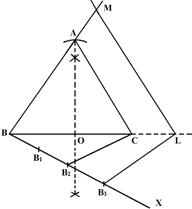 Steps of construction:
i. Draw line segment BC = 5 cm. Construct the perpendicular bisector of BC, on the upper side of BC mark a point A at a distance of 4 cm.
ii. Join AB and AC to get isosceles triangle ABC.
iii. Draw any ray BX making an acute angle with BC on the side opposite to the vertex A.
iv. Locate three points B1, B2 and B3 on BX such that BB1 = B1B2 = B2B3.
v. Join B2 (smaller of 3/2) to C.
vi. Draw a line through B3 parallel to B2C, intersecting the extended line segment BC to L
vii. Draw a line through L parallel to CA intersecting the extended line segment BA to M
viii. Then MBL is the required triangle.
Steps of construction:
i. Draw line segment BC = 5 cm. Construct the perpendicular bisector of BC, on the upper side of BC mark a point A at a distance of 4 cm.
ii. Join AB and AC to get isosceles triangle ABC.
iii. Draw any ray BX making an acute angle with BC on the side opposite to the vertex A.
iv. Locate three points B1, B2 and B3 on BX such that BB1 = B1B2 = B2B3.
v. Join B2 (smaller of 3/2) to C.
vi. Draw a line through B3 parallel to B2C, intersecting the extended line segment BC to L
vii. Draw a line through L parallel to CA intersecting the extended line segment BA to M
viii. Then MBL is the required triangle.
Q5. Draw
two tangents to a circle of radius 3.5 cm from a point P at a distance of 6
cm from its centre O.
Solution
Steps of construction:
1. Take any point O of the given
plane as centre draw a circle of 3.5 cm radius. Locate a point P, 6 cm away
from O. Join OP.
2. Bisect OP. Let M be the
midpoint of PO.
3. Taking M as centre and MO as
radius draw a circle.
4. Let this circle intersect our
circle at point Q and R.
5.
Join PQ and PR. PQ and PR are the required tangents.
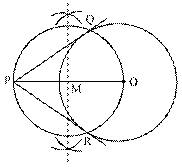

Q6. Draw a circle of diameter 5.8 cm. Draw one of its diameter. Through one of the end points of the diameter, construct tangent to the circle.
Solution

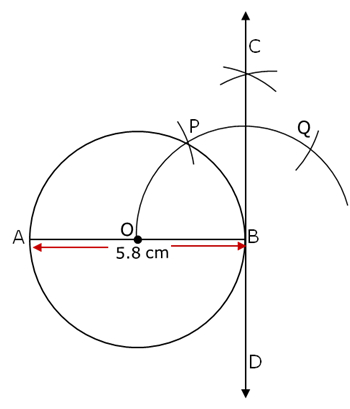
Q7. Construct a right triangle ABC in which BC = 12 cm, AB = 5 cm and  A = 90°. Construct a triangle similar to it and of scale factor
A = 90°. Construct a triangle similar to it and of scale factor  .
.
Solution
Steps of construction are as follows:
1. Draw a line segment AB = 5 cm. At point A construct a right angle SAB.
2. Draw an arc of radius 12 cm with B as its centre to intersect SA at C. Join BC to obtain  ABC.
3. Draw a ray AX making an acute angle with AB, opposite to vertex C.
4. Locate 3 points A1, A2, A3 on line segment AX such that AA1 = A1A2 = A2A3.
5. Join A3B. Draw a line through A2 parallel to A3B intersecting AB at B'.
6. Through B', draw a line parallel to BC intersecting AC at C'.
ABC.
3. Draw a ray AX making an acute angle with AB, opposite to vertex C.
4. Locate 3 points A1, A2, A3 on line segment AX such that AA1 = A1A2 = A2A3.
5. Join A3B. Draw a line through A2 parallel to A3B intersecting AB at B'.
6. Through B', draw a line parallel to BC intersecting AC at C'.
 AB'C' is the required triangle.
AB'C' is the required triangle.
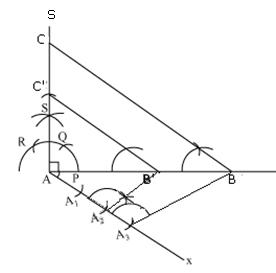

Q8. Draw a circle of radius 3 cm. Take two points P and Q on one of its extended diameter each at a distance of 7 cm from its centre. Draw tangents to the circle from these two points P and Q.
Solution
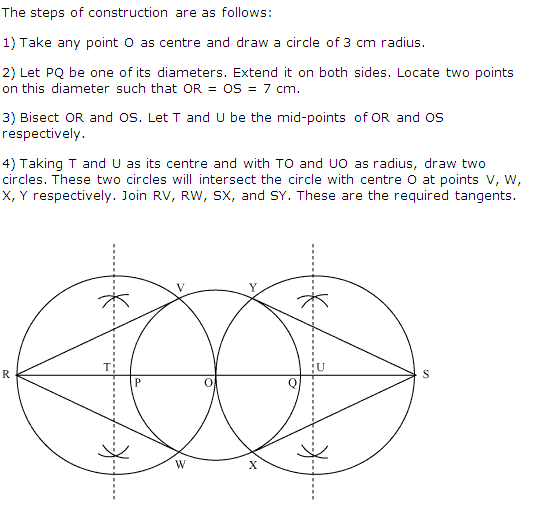
Q9. Construct a triangle similar to  ABC in which AB = 4.6 cm, BC = 5.1 cm,
ABC in which AB = 4.6 cm, BC = 5.1 cm,  A = 60o with scale factor 4: 5.
A = 60o with scale factor 4: 5.
Solution
 Steps of construction :-
(1) Draw a line segment AB of 4.6 cm.
(2) At B draw an angle of 60o.
(3) With centre B and radius 5.1 cm draw an arc which intersect line of angle at C.
(4) Join BC.
(5) At A draw an angle BAX of any measure.
(6)Starting from A, cut 5 equal parts on Ax.
(7) Join x5B
(8) Through x4, Draw x4Q || x5B
(9) Through Q, Draw AP || BC
Steps of construction :-
(1) Draw a line segment AB of 4.6 cm.
(2) At B draw an angle of 60o.
(3) With centre B and radius 5.1 cm draw an arc which intersect line of angle at C.
(4) Join BC.
(5) At A draw an angle BAX of any measure.
(6)Starting from A, cut 5 equal parts on Ax.
(7) Join x5B
(8) Through x4, Draw x4Q || x5B
(9) Through Q, Draw AP || BC
Q10. Construct a triangle ABC in which BC = 5cm, angle B = 75o and the median bisecting BC is 3.6 cm.
Solution
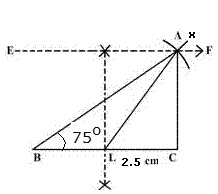 Steps of construction.
i. Draw a line segment BC = 5 cm.
ii. Construct angle CBX = 75o.
iii. Bisect BC at L.
iv. With L as centre and radius 3.6 cm draw an arc cutting BX at A
v. Join AC.
vi. Then triangle ABC is the required triangle.
Steps of construction.
i. Draw a line segment BC = 5 cm.
ii. Construct angle CBX = 75o.
iii. Bisect BC at L.
iv. With L as centre and radius 3.6 cm draw an arc cutting BX at A
v. Join AC.
vi. Then triangle ABC is the required triangle.
Q11. In the figure, P divides AB internally in the ratio:
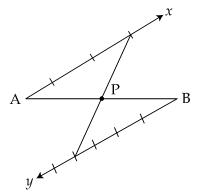

Solution
P divides AB internally in the ratio 3 : 4.
Q12. Draw a circle of radius 1.5 cm. Take a point P outside it. Without using the centre, draw two tangents to the circle from the point P.
Solution
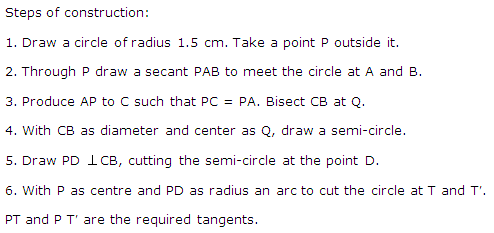
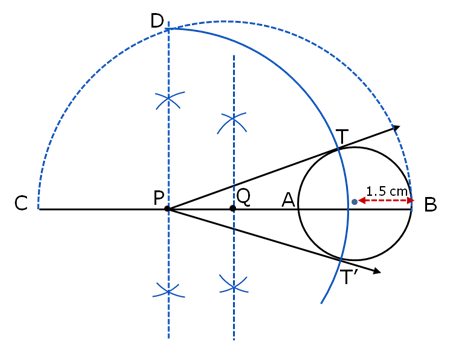
Q13. Construct a triangle similar to a given isosceles triangle PQR with QR = 6 cm, PR = PQ = 5cm such that each of its sides is six- seventh of the corresponding sides of triangle PQR.
Solution
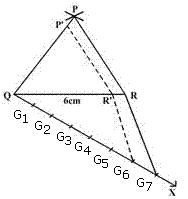 Steps of construction;
Steps of construction;

Q14. 

Solution
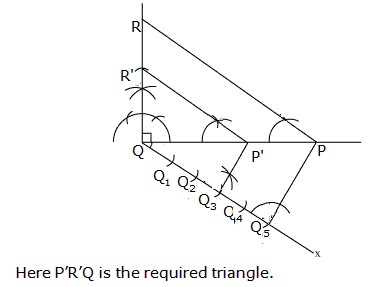
Q15. Given a triangle with side AB = 8 cm. To get a line segment AB' =  of AB, it is required to divide the line segment AB in the ratio:
of AB, it is required to divide the line segment AB in the ratio:
Solution
Q16. Construct a tangent to circle of radius 4 cm through a point P on its circumference.
Solution
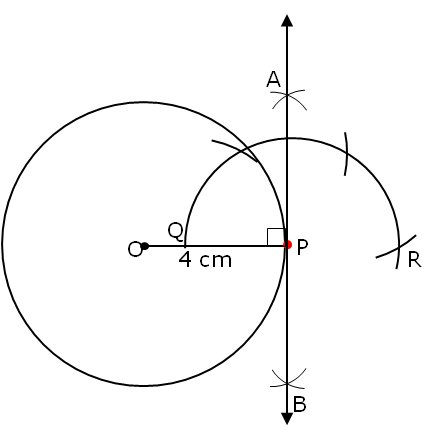 Steps of construction.
i. Draw a circle with centre O and radius = 4 cm
ii. Take a point P on the circumference of the circle.
iii. Join OP
iv. Construct angle OPA = 90o and extend AP to B
v. Then APB is the required tangent to the circle.
Steps of construction.
i. Draw a circle with centre O and radius = 4 cm
ii. Take a point P on the circumference of the circle.
iii. Join OP
iv. Construct angle OPA = 90o and extend AP to B
v. Then APB is the required tangent to the circle.
Q17. Construct a  ABC in which AB = 4 cm, BC = 5 cm and AC = 6 cm. Then, construct a triangle ABC such that
ABC in which AB = 4 cm, BC = 5 cm and AC = 6 cm. Then, construct a triangle ABC such that  .
.
Solution
A triangle ABC is to be constructed such that  . This means that the triangle ABC is similar to the triangle ABC with scale factor as
. This means that the triangle ABC is similar to the triangle ABC with scale factor as  The steps of construction are as follows:
1. Draw a line segment BC = 5 cm.
2. With B as centre and radius = AB = 4 cm, draw an arc.
3. With C as centre and radius = AC = 6 cm, draw another arc, meeting the arc drawn in step 2 at the point A.
4. Join AB and AC to obtain
The steps of construction are as follows:
1. Draw a line segment BC = 5 cm.
2. With B as centre and radius = AB = 4 cm, draw an arc.
3. With C as centre and radius = AC = 6 cm, draw another arc, meeting the arc drawn in step 2 at the point A.
4. Join AB and AC to obtain  ABC.
5. Below BC, make an acute angle
ABC.
5. Below BC, make an acute angle  CBX.
6. Along BX mark off three points B1, B2 , B3 such that BB1 = B1B2 = B2B3.
7. Join B3C.
8. From B2, draw B2C || B3C.
9. From C, draw CA || CA, meeting BA at the point A.
Then ABC is the required triangle.
CBX.
6. Along BX mark off three points B1, B2 , B3 such that BB1 = B1B2 = B2B3.
7. Join B3C.
8. From B2, draw B2C || B3C.
9. From C, draw CA || CA, meeting BA at the point A.
Then ABC is the required triangle.
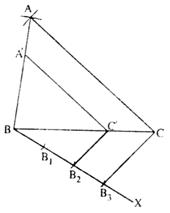

Q18. 

Solution
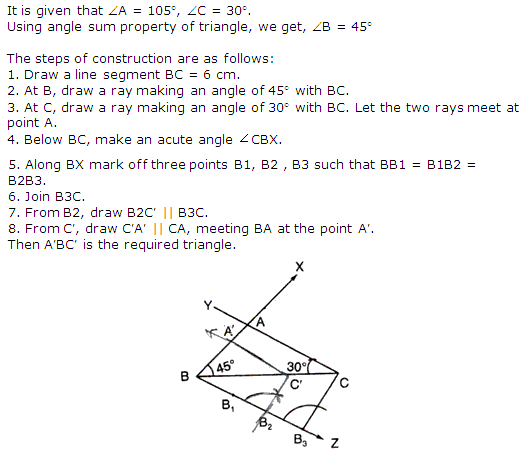
Q19. Draw a
triangle ABC with side BC = 6 cm, AB = 5 cm and  ABC = 60°. Then construct a triangle whose sides are
ABC = 60°. Then construct a triangle whose sides are of the corresponding sides of the triangle ABC.
of the corresponding sides of the triangle ABC.
Solution
Following
steps will be followed to draw a triangle  A'BC' whose sides are
A'BC' whose sides are  of corresponding sides of
of corresponding sides of  ABC.
1. Draw a line segment BC of 6 cm.
Draw an arc of any radius while taking B as centre. Let it intersect line BC
at point O. Now taking O as centre draw another arc to cut the previous arc
at point O'. Joint BO' which is the ray making 60° with line BC.
2. Now draw an arc of 5 cm.
radius, while taking, B as centre, intersecting extended line segment BO' at
point A. Join AC. DABC is having AB = 5 cm. BC = 6 cm
and
ABC.
1. Draw a line segment BC of 6 cm.
Draw an arc of any radius while taking B as centre. Let it intersect line BC
at point O. Now taking O as centre draw another arc to cut the previous arc
at point O'. Joint BO' which is the ray making 60° with line BC.
2. Now draw an arc of 5 cm.
radius, while taking, B as centre, intersecting extended line segment BO' at
point A. Join AC. DABC is having AB = 5 cm. BC = 6 cm
and  ABC = 60°.
3.
Draw a ray BX making an acute angle with BC on opposite side of vertex A.
4.
Locate 4 points (as 4 is greater in 3 and 4). B1, B2, B3,
B4 on line segment BX.
5.
Join B4C and draw a line through B3, parallel to B4C
intersecting BC at C'.
6.
Draw a line through C' parallel to AC intersecting AB at A'. DA'BC' is the required triangle.
ABC = 60°.
3.
Draw a ray BX making an acute angle with BC on opposite side of vertex A.
4.
Locate 4 points (as 4 is greater in 3 and 4). B1, B2, B3,
B4 on line segment BX.
5.
Join B4C and draw a line through B3, parallel to B4C
intersecting BC at C'.
6.
Draw a line through C' parallel to AC intersecting AB at A'. DA'BC' is the required triangle.


Comments
Post a Comment